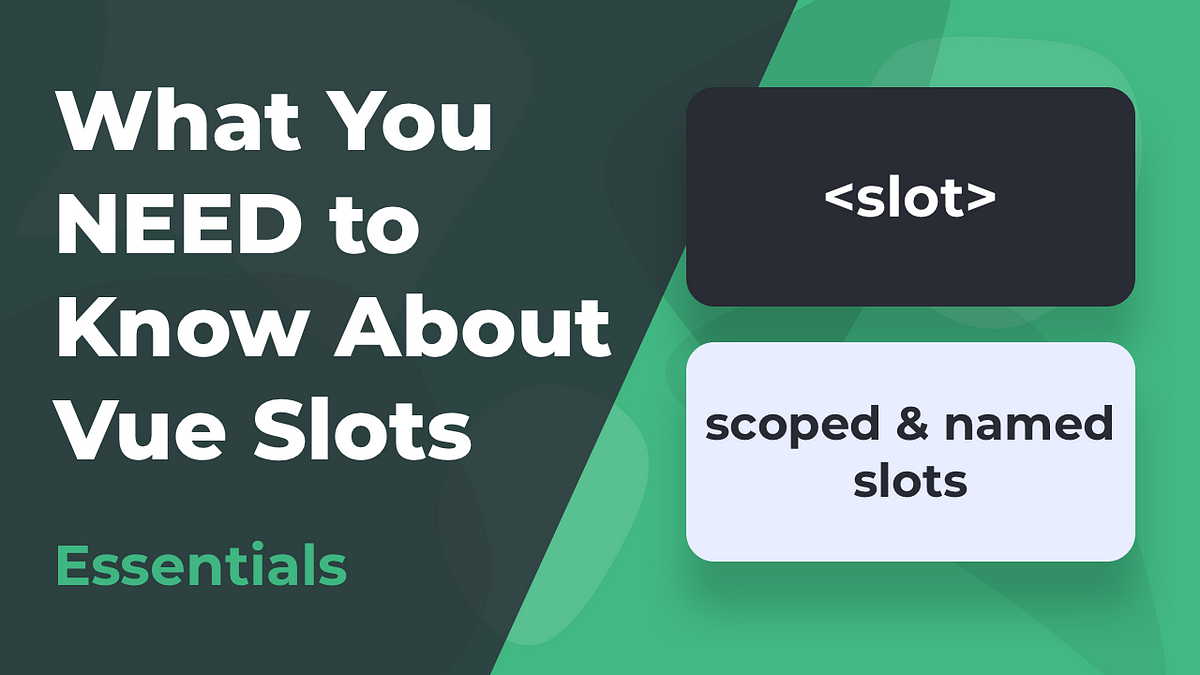The V-Slot Directive is a fundamental concept in Vue.js. Notably, it does not support any modifier, which can be visualized with the following table:
| V-slot Directive | Supports Modifiers |
|---|---|
| V-slot Directive | No |
Vue.js is built on reusable components. The v-slot directive integrates these components intricately. Components are akin to custom elements that Vue’s compiler attaches behaviour to. The v-slot directive allows you to abstract this reusable code into customizable logic units.
However, as represented in the above schema, there is a crucial point about the v-slot directive in Vue.js – this function lacks support for modifiers. Modifiers are helper methods that can optimize or modify events or interactions within Vue.js.
The lack of modifier support in v-slot implies slightly limited functionality and flexibility. Effectively, you cannot readily utilize mouse event modifiers like .stop, .prevent, .self or key modifiers such as .enter, .tab, .delete (or .del), .esc, .space, .up, .down, .left, .right etc directly with v-slot. It means either writing longer lines of code for some actions or finding planned workarounds. These minor drawbacks require additional attention while crafting applications.
One might argue that v-slot’s strength lies in its simplicity and predictability rather than flexibility. Indeed, Steve Jobs once said, “Simple can be harder than complex”, a quote which fits quite well when considering the design decisions behind the V-Slot directive. Rather than adding more features at the expense of its consistency, Vue has opted to provide a stable, simple tool with immense value in managing reusable code.
Reference:
(Vue.js Guide)[https://vuejs.org/v2/guide/components-slots.html]
Exploring the Components of V-Slot Directive

The V-slot directive is a vital part of the Vue.js framework and plays an indispensable role in content distribution within slots. However, a critical aspect to note here is that any modifiers are unsupported by the V-slot directive.
V-Slot Directive Explained
V-slot directive forms the underpinning for scoped slots, allowing us to write a template inside a child component slot. This enriches the Vue.js applications by making components more reusable and configurable. Nevertheless, it’s fundamentally important to understand its limitations, one of which is the lack of support for modifiers.
Components of the V-Slot Directive
The slots empowered by V-slot directive consist of two main components:
-
Name
: This corresponds to the ‘name’ attribute used while creating slots.
-
Scope
: The object that contains props exposed from child to parent component.
However, when delving deeper, you might discover that it doesn’t support any modifiers, unlike other Vue.js directives like v-on and v-model.
Considerations for Implementing V-Slot Directive:
– You have to define scope explicitly. Even though prop values become accessible within the slot scope, they aren’t inherently available in the parent component’s scope.
– Since there’s no in-built support for modifiers, managing events or updated values requires additional efforts.
Despite this apparent drawback, the role of the V-slot directive in building dynamic components cannot be downplayed. Although lacking modifier support, V-slot retains high relevance in using Vue.js to build scalable and easier-to-maintain components.
“Hence code oftentimes is most concise without modifiers.” – Erik Dietrich
This official VueJS guide provides a primer on the V-slot directive, including details on how to use it even with the no support for modifiers constraint.
Unraveling the Functionality of V-Slot Directive Without Modifiers

The V-Slot Directive is a feature found within Vue.js, a popular JavaScript framework. This directive aids developers in creating more meaningful and streamlined code workflows by granting them easier slots functionality for elements, such as templates or components. Despite its diverse range of application areas, it’s noteworthy to mention that the V-Slot Directive does not support any modifiers.
In general, JavaScript functional modifiers are extensions of specific commands that allow developers to further customize their operation. However, when working with the V-Slot directive within Vue.js, it’s essential to understand that no such modifications or adjustments can be implemented. As a result, all interactions with this directive follow a defined process.
A basic representation of how to use the V-Slot directive without modifiers can be written as:
<template v-slot:mySlot> Content goes here </template>
Where `mySlot` represents the slot you intend to work with. We must stress that while different content can be added inside the template, no external modifier can be used to adjust or change the manner in which the V-Slot Directive operates.
Detractors may argue that applying modifiers could be beneficial in certain situations. For example, developers could modify the functionality of the directive, improving flexibility and usability. However, Vue.js posits that unlimited customization could lead to complex structures, yielding harder-to-understand, maintain, and debuggable code.
Bill Joy, co-founder of Sun Microsystems and contributor to BSD UNIX, once said, “Software complexity grows until it exceeds the capability of the developer who must maintain it”. In lockstep with this philosophy, Vue.js designed the V-Slot Directive — a directive that’s less prone to complications by restricting the use of modifiers.
There is an abundance of online resources like the official Vue.js documentation that further explore this aspect and others relating to the V-Slot Directive.
We appreciate the beauty of simplicity in code as we aim to create maintainable solutions. Remembering that ‘the simplest approach is often the best one’, we rely heavily on communication rather than modifiers when using the V-Slot Directive. This, mirroring Linus Torvalds’ advice: “Talk is cheap. Show me the code”.
The Practical Applications of V-Slot Directive in Web Development

The V-Slot directive in web development, particularly with Vue.JS, is a versatile tool that provides useful functionalities for developers. However, it’s crucial to take note that the V-Slot directive does not support any modifier.
1. Building Reusable Components
Arguably, one of the most practical uses of the V-Slot directive in web development is the facilitation of creating reusable components. These components are small, independent and can be used across different parts of a web application.
<template v-slot:header>
could serve as an illustrative instance – facilitating the dynamic import of data to header components.
Please be reminded though, as part of its characteristics, the V-Slot directive doesn’t have modifier support. Essentially, this means that commonly used tools such as .once or .native cannot be used within a V-Slot directive, limiting some aspects of its configuration options. This lacking feature, however, can promote cleaner code by preventing shortcut methods and adhering to traditional practices.
2. Scoping Slots
One more practicality which needs to be highlighted for the V-Slot directive lies in the scoping slots. ‘Scoped Slots’ refers to passing properties from parent components to children directly via the template using
<template v-slot:item="props">
.
While it is an incredibly beneficial feature that lets developer bind values directly from the parent scope, keep in mind that it lacks bolstering modifiers to spice up the directive usages.
As Matt Biilmann, CEO of Netlify once said,
“Javascript frameworks are changing the way we think about and write software.”
Indeed, despite considerations such as the V-Slot directive not supporting any modifier, they still offer powerful features that make web development more streamlined and efficient.
Reference:
VueJS Official Documentation- Scoped Slots
Deep Dive into Issues Arising from Lack of Support for Modifiers in V-Slot Directive

Directives in Vue.js, such as the V-Slot Directive, usually offer support for a variety of modifiers. However, concerns have been raised about the lack of this feature in the V-Slot Directive. Inadequate modifier support within the directive can result in a range of issues — including complexity in passing parameters to events and limitations on technique versatility.
When we want to prevent an event’s default action or stop its propagation up the DOM tree, Vue.js directives often permit this with modifiers. Unfortunately, the same cannot be said of the v-slot directive. The inability to stop propagation or prevent default on events directly from the v-slot can cause problems in specific volatile scenarios. For example, in a nested menu component where clicking a submenu item would close the entire menu.
Under these circumstances, if you can’t use modifiers to stop event propagation from the v-slot directive, it may make the logic more complex involving unnecessary addition of method calls.
Here is a case illustrating this problem:
<template v-slot:item="{ element, close }" @click.stop>
<div @click="element.toggle">Toggle Child Menu</div>
<div @click="close">Close Menu</div>
</template>
In the code above, both ‘element.toggle’ and ‘close’ events might fire concurrently due to the lack of modifier support, causing user interface (UI) inconsistency and hard-to-predict application behavior.
Another concern related to lacking modifier support in v-slot is the limitation imposed on developers in terms of implementing a diverse range of techniques for managing data and events. Developers rely on the flexibility that modifiers provide to handle event data conveniently and from an elementary level in a highly customizable fashion. These restrictions could stifle creativity and limit certain functionalities. Here, it is essential to note how many doors of opportunities get shut due to this specified missing feature.
In the words of Jeff Atwood, a well-known software developer, and co-founder of Stack Overflow, “There are few things more frustrating than having your work rejected… Remember that what you’ve created, you can always refine later, or discard and start anew.” This points toward the idea that there exists an essential possibility for future support in modifiers for v-slot.
Overall, while Vue.js, in general, supports the use of modifiers with directives to foster versatility and enhance productivity, the absence of such support in the V-Slot Directive limits its application scope narrowing down problem-solving techniques and introducing certain complexities to the coding process.
Here is a great resource to understand this problem further from the [Vue.js official documentation] comparing scoped slots with normal slots within the Vue.js framework.
Delving into the Vue.js realm, it’s crucial to understand its fundamentals and intricacies alike. One such critical corner is the lack of support for any modifiers within the V-Slot Directive.
Unlike some directives in Vue.js, V-Slot does not accommodate modifiers. This absence of support implies that developers cannot incorporate variations or alternatives into their coding while using this directive. Although a unique feature in Vue.js like v-on and v-model have modifier capabilities, the inability of v-slot to support any modifier provides two advantages:
| Advantage |
|---|
| V-Slot can be perceived as a simpler tool, as there are no additional intricacies attached to it when compared to directives with modifier support. |
| The chances of errors decrease significantly as there are no modifiable parameters. |
Let’s consider a quick example involving a button event listener in Vue.js. The instance where v-on:click.stop=”doSomething” is used, ‘.stop’ acts as a modifier to stop all propogation of click events. However, if we were to use v-slot here, there are no modifiers which could be attached along with it.
<template v-slot:default="slotProps"> <!-- Slot content --> </template>
Coders across the web will likely relate to Douglas Crockford’s thoughtful quote, “JavaScript is the only language that I’m aware of that people feel they don’t need to learn before they start using it.” As a JavaScript developer, understanding the nuance of Vue.js including the V-Slot directive is paramount. It may seem limiting that the V-Slot directive doesn’t support any modifier, but a fuller understanding benefits us, revealing how this potentially simplifies our code and reduces error probability.
To gain better insights into Vue.js, be sure to refer to the official Vue.js Documentation. It is an excellent resource that provides more in-depth knowledge about directives, slots, and modifiers. Plus, it gives a broader understanding of how these different aspects align to form the complete Vue.js framework.
Although we yearn for customization options within each feature at all times, the simplicity presented by v-slot’s non-flexible nature renders itself as an advantage rather than a disadvantage. The critical thing to remember here is that V-Slot Directive does not support any modifier – and that’s perfectly fine.

